Fiber-Based Polarization Beam Combiner/Splitter, 3 PM Ports
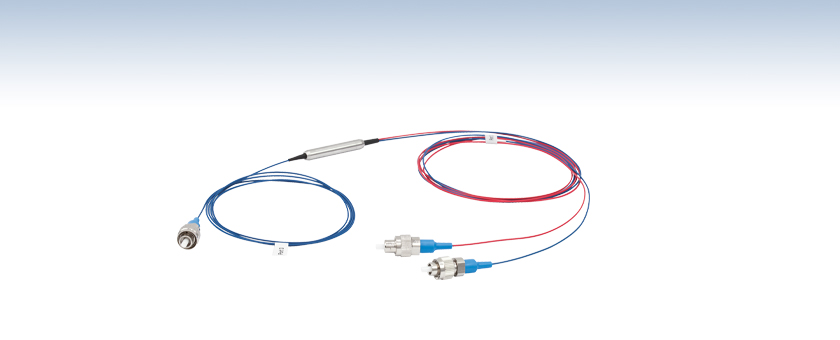
- Combine or Split Orthogonal Polarizations
- 980 nm Operating Wavelength
- Ideal for Combining Pump Laser Signals Prior to Amplification
PBC980PM-FC
Polarization-
Maintaining
Fiber
Polarization-
Maintaining
Fibers

Please Wait
| General Specificationsa | |
|---|---|
| Return Loss | ≥40 dB |
| Fiber Length | 1 m on Each Leg |
| Length Tolerance | +0.075 m / -0 m |
| Jacket | Ø900 µm Loose Furcation Tubing |
| Size | 1.38 " x Ø0.22" (35.0 mm x Ø5.5 mm) |
| Connector Keys | Narrow (2.0 mm); Aligned to Slow Axis for all PM Fiber Legs |
Features
- Combine or Split Orthogonal Polarizations in Fiber Optic Systems
- High Extinction Ratio
- Bidirectional: Three Polarization-Maintaining Ports
- 1 m of Ø900 µm Jacketed Fiber on Each Leg
Thorlabs' Polarization-Maintaining Fiber-Based Polarization Beam Combiner (PBC) or Splitter is designed to either combine two orthogonal polarizations into a single fiber or split a single input into its orthogonal linear polarizations through two fiber outputs. The device on this page features two legs of polarization-maintaining fiber on one side of a calcite prism and one leg of polarization-maintaining fiber on the other. The legs on the side with the two PM fibers have the slow axis of the fiber aligned for maximum transmission of one polarization state.
In the polarization-maintaining PBC, all three legs contain PM fiber. If a polarized beam is aligned to the slow axis of the fiber on port 3, as represented by the yellow arrows in the diagram on the right, then this beam will be deviated by the prism so that it emerges from port 1 with the polarization aligned to the slow axis. Conversely, if the beam entering port 3 is aligned with the fast axis of the fiber, as represented by the green arrows in the diagram on the right, then the light will be deviated by the prism such that it emerges from port 2 with the light aligned to the slow axis. Note that the slow axes of the fibers on port 1 and port 2 are orthogonal to each other to match the polarization emitted by the calcite prism. If the polarization incident on port 3 is at an angle with respect to the axes, the output at ports 1 and 2 will vary depending on the angle of the incident polarization state.
This PM PBC can also be used in reverse: light incident on port 1 along the slow axis will exit from port 3 aligned to the slow axis, and light incident at port 2 with the polarization aligned to the slow axis will exit from port 3 with the polarization aligned to the fast axis. Light incident at ports 1 and 2 aligned to the fast axis of the fibers will refract differently through the prism and will not exit port 3.
This polarization beam combiner is frequently utilized to combine the light from two pump lasers into a single fiber to increase the input into an erbium-doped fiber amplifier or Raman amplifier.
Alternative PBC Options
Versions of our fiber-based PBC using single-mode fiber for the output leg are available here. Thorlabs also offers the FiberBench system, which is a line of products designed for free-space manipluation of light within fiber-based systems. This line includes polarizer and beamsplitter modules for constructing custom PBCs. A prebuilt FiberBench-based variable polarization beam combiner / splitter is also available.
| Fiber Polarization Combiner / Splitter Selection Guide | ||||
|---|---|---|---|---|
| Fused Fiber | In-Line Micro Prism | Free-Space Polarization Beamsplitter Kits |
||
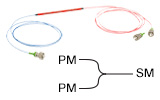 |
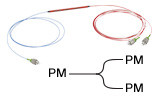 |
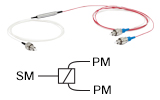 |
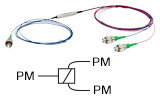 |
 |
| 2 PM Ports, 1 SM Port | 3 PM Ports | 1 SM Port, 2 PM Ports | 3 PM Ports | 3 FiberPort Assembly |
| Higher Power Handling and Higher Transmission | Bi-Directional, Polarizing, Larger Bandwidth | Can be Used with Multiple Fiber Types | ||
| Posted Comments: | |
Miguel Varga
(posted 2019-09-11 05:40:00.443) Hello,
I would like to couple twin photons of 811nm into a PBC780PC-FC in order to split them in function of their polarization.
Do you have a graph of the losses and extrintion ratio for this fiber in function of the wavelength? I would like to know if it is possible to use this fiber for 811nm photons.
Regards,
Miguel YLohia
(posted 2019-10-01 10:53:58.0) Hello Miguel, thank you for contacting Thorlabs. Unfortunately, we do not have a curve for Insertion Loss and Extinction Ratio vs Wavelength. That being said, we do expect the performance at 811nm to be similar to that at 780nm. pierrick.cheiney
(posted 2018-11-30 21:30:09.337) Hello,
Could you offer a combiner at 780 nm such as PBC780PM-APC with a 5 m fiber at port 3. I am interested in buyning 4 combiners. YLohia
(posted 2018-12-03 09:04:48.0) Hello, thank you for your inquiry. Custom combiners/splitters can be requested by emailing techsupport@thorlabs.com. I will reach out to you directly with more information regarding this quote. bernd.sontheimer
(posted 2018-07-09 09:56:03.35) Hello,
can you also offer to offer Fiber-Based Polarization Beam Combiners/Splitters @ ~640 nm? If so, would you please come back to me with a custom quote?
Thanks in advance and best regards! YLohia
(posted 2018-07-09 08:25:28.0) Hello, thank you for contacting Thorlabs. We will reach out to you directly to discuss the possibility of offering this. brendanbramman
(posted 2017-10-03 22:26:54.247) Hello,
Would it be possible to get these Beamsplitting fibers to accommodate wavelengths of: 493nm, 553nm, 614nm, 650nm, 1762nm? If so, could you let me know how much the wait time would be and how much they would cost?
Thanks,
Brendan nbayconich
(posted 2017-10-10 08:10:00.0) Thank you for contacting Thorlabs. I will reach out to you directly with more information about our custom capabilities. Ahmed
(posted 2017-03-10 06:54:12.17) Dear sir
Regarding your PBC780PM-FC product, is it possible to manufacture the same model but the operating wavelength is to be 640 nm? If it is possible, what will be the cost and after what time it could be available?
I'm intending to use it with your nanosecond laser source working at 640 nm .
Thank you in advance for your help
Best regards tfrisch
(posted 2017-03-14 09:00:06.0) Hello, thank you for contacting Thorlabs. I have asked out Technical Support Team to follow up with you about this requested quote for a custom. Roger_Hsu
(posted 2014-11-16 18:01:35.807) Hi, I would like to ask a technical question.
Regarding to the mechanism of PBC, the output combine the two orthogonal polarization from two legs,but will the output polarization varying when I perturb the fiber? Will the output polarization state can be maintained as linear polarization? jlow
(posted 2014-12-22 03:10:37.0) Response from Jeremy at Thorlabs: Since the fiber is PMF, the output change should be negligible when perturbed slightly. The output polarization would be a combination of the two input as shown on the graphic in the overview tab. sivelinu
(posted 2014-06-12 18:10:52.923) Could you please let me know PBS working in 850nm wavelength? pbui
(posted 2014-06-12 12:13:17.0) We currently do not offer a polarization beam combiners centered at 850 nm in our catalog, but we may be able to offer it as a custom item. We will contact you to discuss your exact requirements and to provide a quote. Rudolf.Neuhaus
(posted 2013-11-26 16:00:38.713) Could you please let me know what the maximum allowed power is for this device?
Thanks and best regards,
Rudolf Neuhaus pbui
(posted 2013-12-05 03:26:38.0) Response from Phong at Thorlabs: For the 780 nm wavelength, the connectors from the should be able to accept up to 300 mW power. For power levels greater than this, due to possible misalignment in coupling, hot spots can form, resulting in power leaks that may cause damage to the connector's epoxy. |
 Products Home
Products Home
















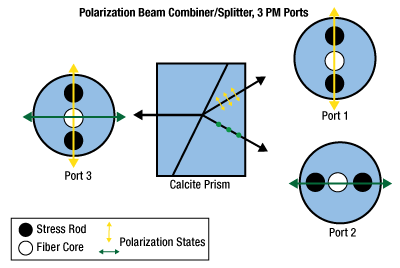

 PM Fiber-Based Polarization Beam Combiner/Splitter
PM Fiber-Based Polarization Beam Combiner/Splitter